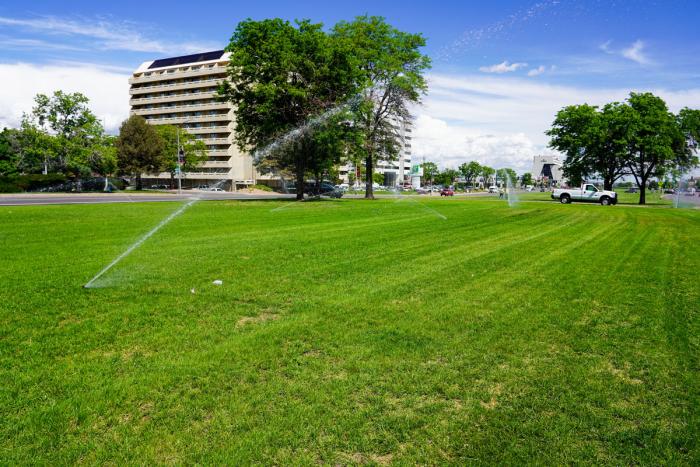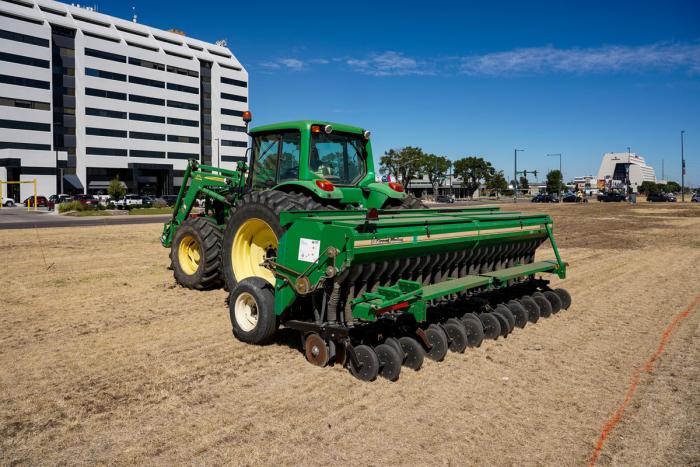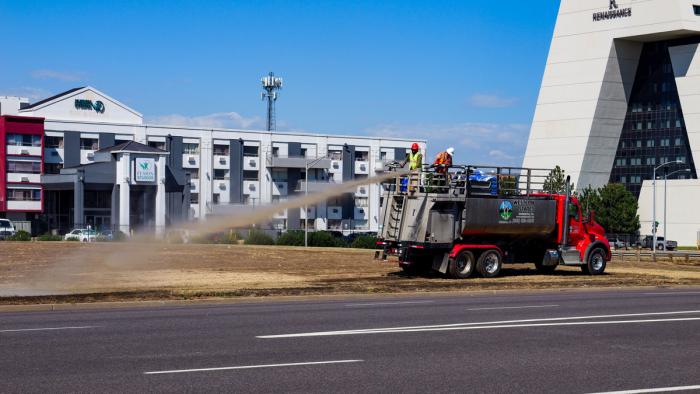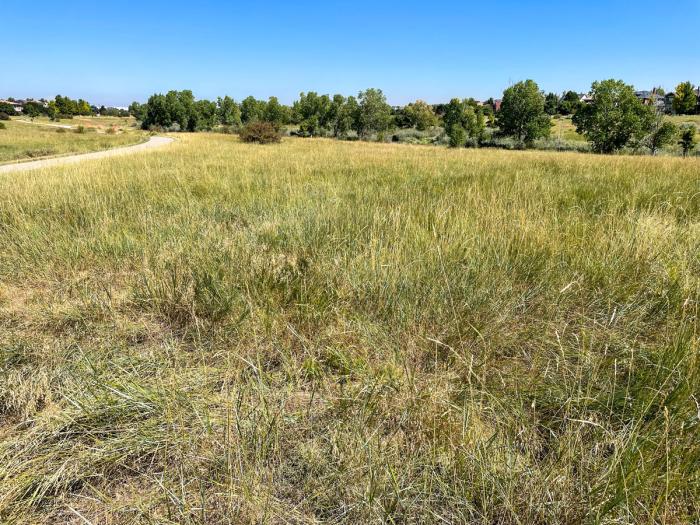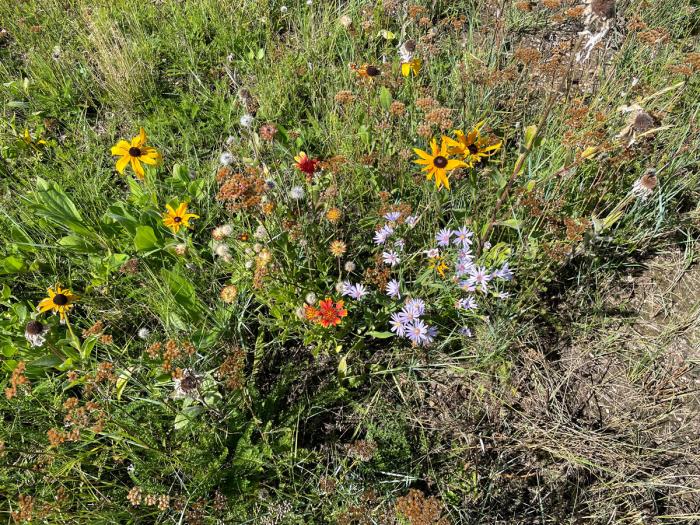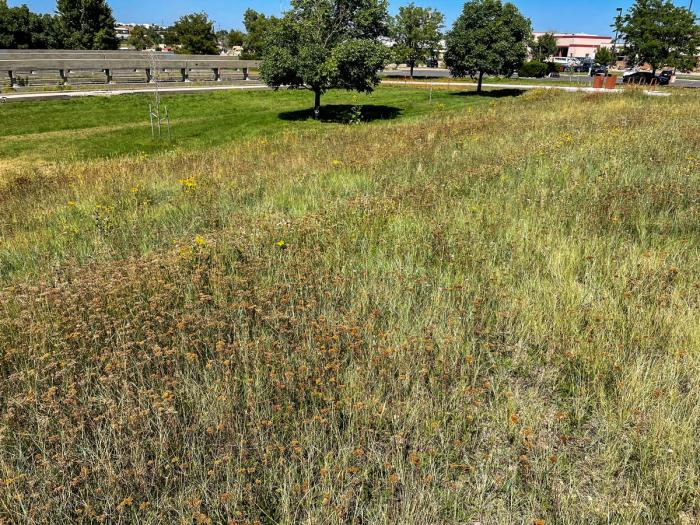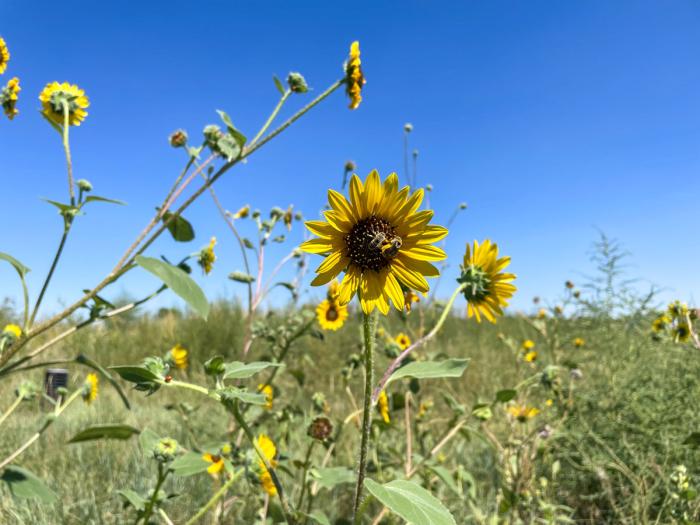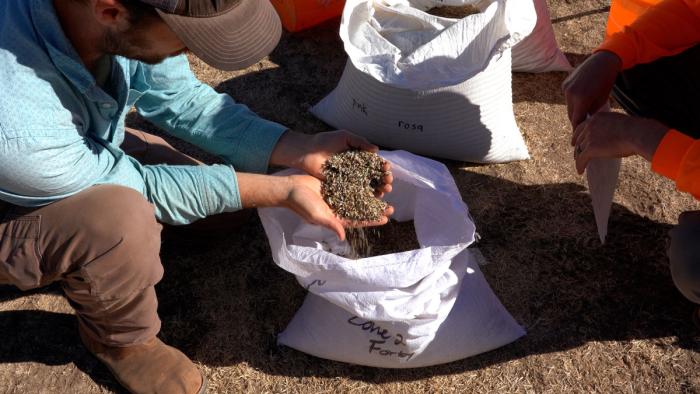Medians get a makeover in Denver’s Central Park
It’s not often that a median in the middle of a street gets a lot of attention, and that makes it a perfect candidate for a landscape makeover.
For decades, the four medians separating the north and southbound lanes of Quebec Street, just south of Interstate 70 between Smith Road and Martin Luther King Jr. Boulevard, have featured 10 acres of thirsty Kentucky bluegrass.
What's out: Bland Kentucky bluegrass. What's in: Climate-resilient prairie grass. Learn more.
Now, the Denver Parks and Recreation department is transforming the grass fields into prairie grass meadows that will be home to a more appropriate type of ColoradoScape that needs significantly less water to thrive.
“The medians had what we call ‘nonfunctional grass,’ which means the grass was not being used for any type of activity. That made it a perfect location for landscape transformation,” said Ian Schillinger-Brokaw, a Denver Parks and Recreation urban ecology planner.
“We were using around 9 million gallons of water every year to keep grass green that no one used, so it was really not a good use of water.”
The landscape transformation project on the four medians is being done in partnership with Denver Water, which is helping to fund the work.
The project also received money from the Colorado Water Conservation Board’s Turf Replacement Program, which uses state funds to help transform water-intensive turf into a more natural ColoradoScaped environment.
What to expect
During summer 2023, the city shut off the sprinklers and let the bluegrass die. Then in September, landscape crews from Western States Reclamation planted more than 60 species of prairie grasses and wildflower seeds through the remains of the dead bluegrass.
Learn more about ColoradoScaping at denverwater.org/Conserve.
After the seeds were in the ground, workers sprayed the field with “hydromulch,” which is the process of spraying water mixed with small particles of wood fiber on top of the seeds, so they don’t blow away or get eaten by birds.
The field will be watered over the next two to three years to help the seeds grow. Depending on the weather, some grasses will sprout this fall, while others will begin to grow next spring and summer.
It will take roughly three years for the new plants to become established.
"The field will have a variety of grasses with different heights, colors and textures and the wildflowers will provide an added boost of color,” Schillinger-Brokaw said.
The wide variety of plants will help the new prairie meadows thrive in different weather conditions. For example, some grasses and flowers will do better in dry years, while others will grow better in wet years.
“By adding a variety of grass species, we’re ensuring that each season the field will have plants that are in good shape,” he said.
“The field will look very similar to some of our other parks and open spaces in the area, such as Westerly Creek and Prairie Meadows parks.”
Schillinger-Brokaw said the landscape will keep safety in mind by making sure plants around the corners of the medians will be shorter, so they won’t impact drivers’ ability to see other cars and make safe turns at the intersections.
Water savings
Before the landscape conversion, the field required roughly 9 million gallons of extra water every year to keep the Kentucky bluegrass green. By transitioning to a prairie meadow, the goal is to eventually stop watering the field and let Mother Nature provide all the moisture the plants need to survive, Shillinger-Brokaw explained.
The Denver Parks and Recreation department will continue to water the trees on the medians. However, by eliminating the extra irrigation that the bluegrass needed, the overall water use for the medians could be reduced by roughly 8.5 million gallons each year once the plants are established.
“Kentucky bluegrass has been used as the default form of landscaping for decades across many parts of Colorado, but it requires a lot of water,” said Austin Krcmarik, a water efficiency planner at Denver Water.
“With water being such a scarce resource across the West, it’s great to see Denver Parks and Recreation switching to landscaping that fits our climate.”
Additional benefits
The new medians full of prairie grasses and wildflowers are an example of ColoradoScaping, which is landscaping that features low-water-use plants that thrive in our state’s semi-arid climate.
Along with water savings, ColoradoScaping provides additional benefits for Denver’s parks, such as:
- Providing more resilient landscapes that can cope with extreme weather, such as drought.
- Adding biodiversity to the city with new habitats for pollinators such as birds and bees.
- Establishing areas that improve stormwater drainage and improve water quality.
- Eliminating the need for mowing the medians regularly throughout the summer.
- Saving money on water bills that can be used for other park improvements. (The water savings on the Quebec Street project will save Denver Parks and Recreation roughly $20,000 each year.)
Saving water across the West
Water-saving projects like the Quebec Street median turf conversion are critical because Denver Water gets half of its water supply from the Colorado River Basin, which has seen drought conditions over much of the last 23 years.
“Denver Water and other utilities across the West are actively promoting and working with cities and park districts to look for areas of nonfunctional Kentucky bluegrass and see if other types of landscaping is a better fit to help save water,” Krcmarik said.
It’s In Denver’s Nature
The transformation of the Quebec Street medians is an example of Denver Parks and Recreation implementing the Game Plan for a Healthy City.
The comprehensive plan serves as a roadmap to the future of Denver’s park system. A key aspect is investing in the fight against climate change through conserving water, transforming landscapes, growing the urban canopy and protecting habitats.
As part of the plan, in April 2023, Denver Parks and Recreation changed its policy of using thirsty turfgrass, like Kentucky bluegrass, as its primary landscaping groundcover in areas with no recreational value. The Quebec Street medians are an example of how the city is using drought-tolerant and ecosystem-friendly plants instead of turfgrass.
“We’re doing a lot across the city to reduce our water footprint and the Quebec Street medians project is one of the biggest landscape transformation projects we’ve done,” Shillinger-Brokaw said.
“We ask for patience as these new grasses grow, and we’re excited to see the new look coming soon to this part of the city.”
For more information about landscape transformation across the city, check out Denver Parks and Recreation’s It’s In Denver’s Nature campaign and denverwater.org/Conserve.


